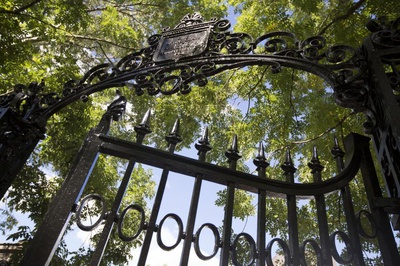
News
Harvard Grad Union Agrees To Bargain Without Ground Rules

News
Harvard Chabad Petitions to Change City Zoning Laws

News
Kestenbaum Files Opposition to Harvard’s Request for Documents

News
Harvard Agrees to a 1-Year $6 Million PILOT Agreement With the City of Cambridge

News
HUA Election Will Feature No Referenda or Survey Questions
The HUA Formed a Team to Resolve a Constitutional Crisis. It’s Not Going Well.

The Harvard Undergraduate Association has a problem: its problem solving team is better at creating problems than solving them.
In accordance with its constitution, the HUA formed a problem solving team in April to resolve a constitutional crisis that caused all student referenda to be indefinitely postponed pending the problem solving team’s recommendations.
But the problem solving team never did any work.
Though members were appointed to serve on the body in April, the team never appointed a chair or a secretary. The team also blew past its July deadline for issuing recommendations to the HUA.
Assistant Dean of Student Engagement and Leadership Andy Donahue, who serves as the College’s official adviser to the HUA, wrote in a Wednesday morning email to the problem solving team that the group’s months-long inaction had effectively created a second constitutional crisis for the student government.
“The lack of progress by the Problem-Solving Team and the lack of clarity in the HUA Constitution has left the student government in a bind,” Donahue wrote.
“I propose that the HUA submit a proposal for a new referendum process to this collective for review. If this group approves of the proposal, the HUA will implement its new language and plan,” Donahue added. “Otherwise, the HUA is seeking to dissolve this problem-solving team and form a new problem-solving team to address the issue.”
In an email exchange obtained by The Crimson, Sanaa M. Kahloon ’25, a member of the problem solving team, wrote back to Donahue that the “team has reached a consensus on moving forward with your proposal and voting on an HUA proposal.”
HUA Co-Presidents Ashley C. Adirika ’26 and Jonathan Haileselassie ’26 wrote to The Crimson on Wednesday night that the problem solving team’s response constituted “a key step towards making progress and improving the HUA’s governing document.”
Donahue’s email marked the latest failure for the HUA’s problem solving team. In late April, the team held their first — and so far only — meeting, where they agreed to reach out to scholars at the Harvard Kennedy School and Harvard Law School for advice on how to improve the HUA’s constitution.
On Sept. 5, hours after The Crimson reported on the problem solving team blowing past its July deadline, Haileselassie wrote in a text message to the problem solving team that the group needed to discuss its progress.
“I’m sure you’re aware of the recent article in the Crimson with regard to the progress made by the Problem Solving Team,” Haileselassie wrote. “The progress, or lack thereof, is a conversation that needs to be had amongst you all — the members who volunteered to lead and make up this specific body.”
In the text, Haileselassie also asked the members of the problem solving team for an update on their progress and if they had any plans to issue recommendations to the HUA.
“If there are no finalized recommendations/proposals, is there a plan or system in place to ensure a finalized recommendation is ready soon?” Haileselassie asked.
Besides one member of the team reacting with an exclamation to Haileselassie’s message, his text was ignored.
Lorenzo Z. Ruiz ’27, a member of the problem solving team, said the team has had “no incentive” to issue recommendations to the HUA because the team’s work would not be binding.
“The fact that we can’t give anything that’s binding or sufficient to solve all their problems means the problem solving team’s a joke — of course, there’s no incentive for us to fix the problem, because no matter what we give them, it’s their call at the end of the day,” said Ruiz, a Crimson Editorial editor.
Donahue wrote in a statement Wednesday night that he emailed the problem solving team after consulting with HUA leadership.
“After the initial meeting in the Spring, the Problem-Solving Team did not share recommendations by the proposed deadline and has not had any further communication with the HUA,” he wrote. “As the advisor to the HUA, I reached out to propose a solution to solving the Constitutional issue and allow all the community to move forward.”
Adirika and Haileselassie wrote in a separate statement to The Crimson Wednesday night that “it’s important that this constitutional question be resolved, so that the HUA can move forward and meet the needs of the student body.”
“To ensure progress is being made to that end, the HUA will be drafting a proposal for review by the problem solving team members,” the co-presidents added.
However, Ruiz said that the HUA’s latest plan — having the problem solving team vote on the HUA’s own recommendations — gives the student government’s leadership too much power.
“We’re a group of random people, and it feels at this point that they’re just using us as a rubber stamp for whatever it is they’d like to do,” Ruiz said.
“I think what it does ultimately is gesture at the fact that the HUA is fundamentally a body that is not representative of the will of the student body and is largely disconnected from the public interest,” he added.
—Staff writer Cam N. Srivastava can be reached at cam.srivastava@thecrimson.com. Follow him on X @camsrivastava.
—Staff writer Adithya V. Madduri can be reached at adithya.madduri@thecrimson.com. Follow him on X @adithyavmadduri.
Want to keep up with breaking news? Subscribe to our email newsletter.
Most Read
- 3 Harvard Students, 2 Recent Grads Had Visas Revoked
- It’s Time To Disband the PSC — Permanently
- Harvard Advises International Students To Reconsider Travel, Assess Risks From Pro-Palestine Speech
- As Trump Waits for Harvard’s Reply, Governing Boards Meet in Harvard Square
- Billionaire Investor Gerald Chan Under Scrutiny for Neglect of Historic Harvard Square Theater
From Our Advertisers

Over 300+ courses at prestigious colleges and universities in the US and UK are at your disposal.

Where you should have gotten your protein since 1998.

Serve as a proctor for Harvard Summer School (HSS) students, either in the Secondary School Program (SSP), General Program (GP), or Pre-College Program.

With an increasingly competitive Law School admissions process, it's important to understand what makes an applicant stand out.

Welcome to your one-stop gifting destination for men and women—it's like your neighborhood holiday shop, but way cooler.

HUSL seeks to create and empower a community of students who are seeking pathways into the Sports Business Industry.
